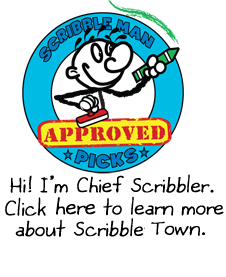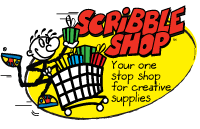Sari Toivola (Sari): Hi! I’m Sari Toivola a Graphic Designer and Illustrator from Vantaa, Finland. I love drawing, designing, comics, history, horses and cats.  I’m working as a Graphic Designer and Illustrator and my business name is Sari ja kuva. I am also a qualificated special needs assistant and have worked with kids, so I’m really excited when I get a chance to create something for them!
I’m working as a Graphic Designer and Illustrator and my business name is Sari ja kuva. I am also a qualificated special needs assistant and have worked with kids, so I’m really excited when I get a chance to create something for them!

Katteja by Sari Toivola
Scribble Town (ST): Thank you Sari for being with us at Scribble Town! I like your business name ‘Sari ja kuva’ because when I did a translation of it from Finnish to English it means ‘Sari and picture’. I started playing around with your words and found that if you put them all together (take away the i) sarjakuva means cartoon! How clever of you to come up with that name! It makes perfect sense why a girl named Sari from Finland should be an illustrator and comic lover.
With that said please tell us more about yourself. What are you up to these days?
Sari: At the moment, I’m doing different kind of works for small companies, associations and private persons. Drawing and designing isn’t only work for me, it’s also a hobby and a lifestyle.

Wonderland by Sari Toivola
ST: What do you like most about illustrating?
Sari: Drawing is creative and the most natural way for me to express myself. By drawing you can mix reality and fantasy, only sky (and your own imagination) is the limit. It’s also rewarding to draw for some specific purpose where illustration is supposed to be a part of the big picture and support, for example, a text. I’m always trying to create something a bit new and bring the subject a new point of view. I also want to express feelings through my pictures, hoping they will touch the viewers as well.
-

- Hundra Hundarna “One hundred dogs” by Sari Toivola
ST: What is your favorite place to create?
Sari: Most of the time I work at home but some days it’s also nice to go to a nice coffee house and work there. It totally depends on my mood… If I’m tired I’d rather stay at home but sometimes it’s good and healthy to go outside and then I usually pick a nice place with some background noise which helps me concentrate. 
ST: What art techniques or tools do you like to use?
Sari: Mostly I draw digitally on the computer using a mouse and a few programs, but I also use pencils and markers for sketching. I usually start a new work by drawing and sketching by hand. Then I scan my sketches and finish the work with a computer by drawing the lines and coloring.
-

- Miimikot by Sari Toivola
ST: Where do you get your inspiration from?
Sari: I get my inspiration from every day life, people, animals, and nature. I’m also very into European history of arts and culture. This is one of the things that inspires me most.
-

- Hamlet by Sari Toivola. Ollako vai eikö olla? To Be or Not to Be?
ST: Do you have a craft, piece of art, or art technique you can share with our Scribblers for them to make at home? Any tips would be great!
Sari: I have been working with an intreresting technique lately called “Taikataikina,” which translates to “Magic Dough.” Everyone can make it, you just need some wheat flour, salt, water and cooking oil. You can handle it like play dough or clay and it can be harden in a regular oven.
Instructions on how to make Taikataikina aka Magic Dough:

Taikisnaamio or Magic Dough by Sari Toivola
3 dl wheat flour
1½ dl salt
1½ dl water
(dl= deciliter)
1 spoon of oil
If you like you can also add a hint of food colouring to the dough for more color. 
Mix all the dry ingredients together and then add water and oil. Fold the dough until it’s smooth and then start creating.
If you don’t use all the dough at once, keep the rest of the dough in fridge so you can use it later.
Finished artworks can be harden by heating them in an oven about an hour in 125 celsius degrees. Hardened works can be painted and varnished by using water colours, acrylics or permanent markers.

Sari Toivola's Taikisnaamio or Magic Dough going in the oven
This dough is very easy to make and simple to work with. It’s 100% non-toxic, so it’s also suitable for small children. And it is cheap and can be hardened at home without any complicated or expensive equipment. 
Here are a couple of photos of fresh Magic Dough Masks waiting to get cleaned up and colored. 
ST: What a great idea, Sari! Perhaps the Scribblers out there could make their own Magic Dough and send in pictures of their creations. We can post your Magic Dough sculptures on the Scribble Blog. I’m definitely ready to get my hands all floured up and turn 2D into 3D!

Here's what Felipe, Christian, M, & Pierre look like with color! Painted by Sari Toivola
After the Magic Dough creations bake in the oven you can paint them. To the left are Felipe, Christian, M, and Pierre with rosy lips and faces full of color.
For more info about Sari and her artwork please have a look at www.sarijakuva.fi. I’m sure she’d love hear from you! In Finnish you can say “moi” or “hei” for hello. Hay is not just for horses in this part of the world 
Thanks Sari for all the inspiration you have given us!
Scribblers, don’t forget to send in jpegs of your Magic Dough creations to . Can’t wait to see what you’ve come up with!

Kissalumiukko "A Snowman Cat" by Sari Toivola

Kameleonttilinnut ja neljä vuodenaikaa "Cameleon birds and the four seasons" by Sari Toivola

My Life and Ego by Sari Toivola
 Photo: Ginette Lapalme
Photo: Ginette Lapalme Photo: Scandinavian Deko
Photo: Scandinavian Deko Photo: Uploaded by
Photo: Uploaded by 








































